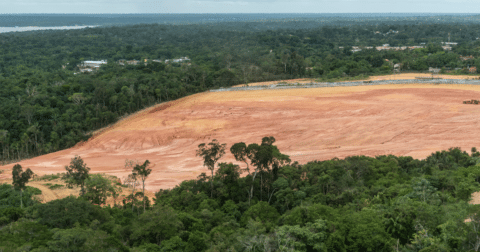Solutions
Urban Foragers Are Mapping Edible Plants Around the World
Climate•5 min read
Explainer
Lula is much, much better for the environment. But can he reverse Bolsonaro’s damage?


Words by Seth Millstein
The Amazon rainforest is one of the most biodiverse regions on the planet, and plays a crucial role in maintaining Earth’s ecosystem. It’s also being slowly destroyed from within by cattle farmers, loggers, corporations and others who wish to develop the land for other purposes. But Brazil’s new president Luiz Inácio Lula da Silva is decidedly against this development, and new data shows that Amazon deforestation is falling dramatically under Lula.
When anti-environmentalist Jair Bolsonaro assumed the Brazilian presidency in 2019, he gave developers free rein of the Amazon rainforest, 60 percent of which is in Brazil. This, along with other policy decisions, led to a staggering increase in deforestation, alarming environmentalists and climate scientists around the world. By 2021, scientists were shocked to discover that some parts of the Amazon had been so overdeveloped that they now emit more carbon than they store.
But in 2022, Bolsonaro lost reelection to Lula, a former two-term president himself who’d overseen dramatic reductions in deforestation during his earlier administrations. Lula pledged to crack down on deforestation in the Amazon rainforest once again, and after his first year in office, he’s made good on that promise.
The Amazon captures enormous amounts of carbon dioxide from the atmosphere and is one of the most biodiverse areas on Earth. It’s also home to millions of Indigenous people and several species who don’t live anywhere else.
The Amazon rainforest, simply by existing in its natural state, plays a crucial role in fighting climate change. That’s because it’s traditionally been one of the world’s biggest carbon sinks, meaning it absorbs and sequesters more carbon dioxide from the atmosphere than it emits. Carbon dioxide makes up more than three-quarters of all greenhouse gasses, which makes carbon sinks like the Amazon an invaluable tool in the fight against global warming.
In addition to sequestering carbon on a massive scale, the Amazon is also one of the most biodiverse places on Earth. An extraordinary array of plant and animal species call the Amazon their home — over three million, to be exact, including 2,500 species of tree and more species of primate than anywhere else. Some animals, such as the gray wooly monkey and the giant otter, are only found in the Amazon.
Humanity depends on a certain level of biodiversity to survive; we need birds and bees to pollinate our crops, we need trees to oxygenate the air, we rely on various plants for their medicinal properties, and so on. The Amazon provides a huge chunk of this biodiversity.
The Amazon is also home to 2.2 million Indigenous people who rely on the region’s natural resources to survive. It’s important to note that, according to a 2023 study, Amazon land that’s controlled by Indigenous people is far more efficient at sequestering carbon than non-Indigenous land — so much so that the rainforest, in totality, would not be a carbon sink if not for the stewardship of the Indigenous people who live there.
Cattle farming is the culprit behind 80 percent of Amazon deforestation. The Brazilian government has encouraged development in the rainforest at various points, beginning in the 1960s. The vast majority of Amazon deforestation is performed illegally.
Amazon deforestation can be traced back to the 1960s, when the country’s military dictatorship declared the Amazon a “security risk” due to its lack of development, and enacted policies to encourage settlement and investment in the area. This led to agricultural development, which in turn attracted more people and capital to the region, and laid the groundwork for the deforestation we’re seeing today.
There are a number of reasons why people cut down trees in the Amazon, but the biggest by far is cattle ranching. Around 80 percent of deforestation in the Amazon is carried out to make way for cattle farms. The second-most-common reason for deforestation has traditionally been soybean farming (mostly to grow feed for cattle and other farm animals), although a 2006 agreement known as the Soy Moratorium has significantly slowed this practice. Logging, gold mining and other activities make up a small minority of development in the area.
It has to be stressed that the overwhelming majority of deforestation in the Amazon is carried out illegally; reliable statistics on this are difficult to come by, but one study cited by the World Wildlife Federation estimated that as much as 94 percent of Amazon deforestation is illegal. This means that from a governmental perspective, reducing deforestation is almost entirely a matter of regulation and enforcement.
The two Brazilian presidents discussed in this piece altered the trajectory of deforestation largely by either strengthening regulatory enforcement or weakening it.
It’s been pointed out that deforestation in the Amazon is a tragedy of the “commons problem”: because the Amazon is of global importance to the entire world, the benefits of preserving it are dispersed more or less equally across the entire population, and those benefits are difficult for any one person to immediately perceive. But when the Amazon is deforested, the beneficiaries are a small number of people who profit immensely from doing so. As such, developers generally feel a stronger incentive to deforest the land than most non-developers feel to protect it.
In an attempt to overcome this dilemma, eight South American countries whose territories encompass parts of the Amazon signed a joint agreement in 2023, pledging to protect the rainforest, and laying out specific steps and benchmarks for doing so.
During his single term as Brazil’s president, Bolsonaro encouraged illegal deforestation by gutting the country’s regulatory agencies and decreasing its regulatory enforcement. Under his rule, deforestation of the Amazon increased by 75 percent and reached a 15-year high.
Though Bolsonaro only served one term as Brazil’s president, his pro-deforestation policies wrought havoc on the country’s rainforest, and still cast a long shadow today.
The Bolsonaro administration promoted, enabled and expedited the destruction of the Amazon in a number of ways. It slowed and reduced enforcement of environmental regulations meant to protect the rainforest, slashed the Ministry of the Environment’s budget, and fired government officials who’d successfully reduced deforestation in the past.
“The government seems to be letting people grab public lands,” Marcelo Horta, a sociologist who works with Indigenous Amazonians, told CNN in 2022 before Bolsonaro’s term ended. “Trees are being knocked down and burnt in order to create grazing pastures. They just keep going. No one does anything about it.”
Outside of his administration’s policies, some of Bolsonaro’s public comments on the matter are also worth noting. He said that deforestation is “cultural” and that those concerned about it were suffering from “environmental psychosis.” He accused environmental NGOs of setting forest fires, when in fact most forest forest fires in the Amazon are started by farmers and loggers. When the G7 offered Brazil $22 million to fight those fires, Bolsonaro said he wouldn’t accept it until French President Emmanuel Macron apologized for calling him a liar.
Bolsonaro’s opposition to protecting the Amazon rainforest was largely a political calculation. Despite the catastrophic environmental impacts of deforestation, many Brazilians who work in the agriculture sector, especially cattle and soybean farmers, don’t want government oversight or regulation of the rainforest, because it cuts into their bottom line. These voters strongly supported Bolsonaro, as did the farm lobby.
The consequences of Bolsonaro’s policies and statements couldn’t be clearer. Under his administration, deforestation increased by an average of 75 percent from the previous decade. During his first three years in office, a staggering 8.4 million acres of the Amazon were deforested, an area larger than the country of Belgium; by the time he left office in January 2023, an additional 3.5 million acres had been deforested. In November 2021, Amazon deforestation was higher than at any point in the previous 15 years.
“Bolsonaro’s government may be over, but his tragic environmental legacy will still be felt for a long time,” Marcio Astrini, executive secretary of the Brazilian Climate Observatory, said in a statement.
By beefing up regulatory enforcement and cracking down on illegal development, the Lula administration has overseen a 55 percent decrease in Amazon deforestation in its first year.
While campaigning for president, Lula pledged to reverse Bolsonaro’s pro-deforestation policies and prioritize the conservation, rather than destruction, of the Amazon rainforest. And he’s made good on that promise since taking office in January 2023.
The Lula administration sought to protect the Amazon from deforestation in a number of ways, including:
The efforts have paid off. During the first seven months of Lula’s presidency, deforestation in the Brazilian Amazon dropped by 43 percent. By the end of the year, it had fallen by 55 percent and reached a five-year low. As a result of this drop in deforestation, it’s estimated that the Amazon emitted 200 million fewer tons of CO2eq in 2023 than it otherwise would have.
It shouldn’t be surprising that Lula was able to reduce deforestation by so much in 2023, given that he already accomplished the same thing 20 years ago. Between 2003 and 2011, when Lula last held the presidency, deforestation in the Amazon fell by 75 percent compared to the 1995-2006 average.
Scientists are not uniformly in agreement on whether it’s too late to reverse the fact that parts of the Amazon now emit more carbon than they absorb, but many believe it’s not too late if aggressive action is taken.
Lula says that his goal is to reach “zero deforestation” by 2030. This doesn’t mean replacing all deforested land with new trees, but rather, ending all deforesting efforts so that no additional trees are cut down. That’s an extremely ambitious goal, but it’s not entirely unrealistic: an analysis that researchers at Oxford carried out before Lula’s election predicted that if he won, deforestation could decrease 89 percent by the end of the decade.
That would depend, of course, on Lula winning reelection. It would depend on a lot of things happening that are impossible to predict this far ahead of time, but one thing is clear: The Lula administration’s aggressive anti-deforestation moves have already produced significant results, and if it continues on this track, the Brazilian Amazon might just continue to benefit humans, animals and the rest of the planet for generations to come.